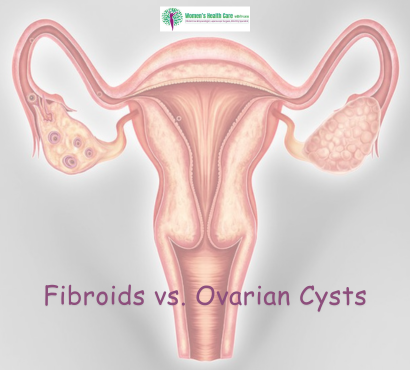Women’s reproductive health is complex, and two common conditions that often cause confusion are fibroids and ovarian cysts. While both can affect fertility, menstrual cycles, and overall well-being, they are not the same. Understanding the differences, symptoms, and treatment options for fibroids and ovarian cysts is crucial for women to make informed healthcare decisions.
aims to provide a comprehensive guide to distinguish between fibroids and ovarian cysts, their causes, risk factors, and available treatments.
What Are Fibroids?
Fibroids, also called uterine leiomyomas or myomas, are non-cancerous growths that develop within the uterus (womb). They are made up of muscle tissue and fibrous tissue and vary in size—from as small as a seed to as large as a melon.
Key Characteristics of Fibroids:
- Origin: Inside or on the wall of the uterus.
- Nature: Solid, firm growths.
- Growth: Hormone-dependent, especially influenced by estrogen and progesterone.
- Common Age Group: Most common in women aged 30–50 years.
What Are Ovarian Cysts?
Ovarian cysts are fluid-filled sacs that develop inside or on the surface of the ovaries. Unlike fibroids, they are usually soft and filled with fluid. Many cysts are harmless and resolve on their own, but some may cause problems.
Key Characteristics of Ovarian Cysts:
- Origin: Inside or outside the ovary.
- Nature: Fluid-filled, sometimes containing tissue or blood.
- Growth: Often linked to the menstrual cycle or conditions like polycystic ovary syndrome (PCOS).
- Common Age Group: Can affect women of all ages, especially during reproductive years.
Major Differences Between Fibroids and Ovarian Cysts
| Feature | Fibroids | Ovarian Cysts |
| Location | Uterus (womb) | Ovaries |
| Composition | Solid muscle and fibrous tissue | Fluid-filled sac (sometimes mixed tissue) |
| Growth Factor | Hormone-dependent (estrogen, progesterone) | Often related to ovulation or PCOS |
| Symptoms | Heavy bleeding, pelvic pain, infertility | Bloating, irregular periods, pain |
| Treatment | Medication, surgery (myomectomy, hysterectomy) | Observation, hormonal therapy, surgery if large |
Symptoms of Fibroids
Fibroids may be symptomless in some women, but when symptoms occur, they can include:
- Heavy or prolonged menstrual bleeding
- Pelvic pain or pressure
- Enlarged abdomen or bloating
- Frequent urination (due to pressure on the bladder)
- Constipation (if pressing on the rectum)
- Painful intercourse
- Difficulty conceiving or pregnancy complications
Symptoms of Ovarian Cysts
Ovarian cysts also vary in presentation. Many small cysts go unnoticed, but larger or persistent ones may cause:
- Pelvic pain (sharp or dull)
- Bloating or abdominal swelling
- Pain during sex
- Irregular menstrual cycles
- Nausea or vomiting (if cyst ruptures)
- Difficulty emptying the bladder or bowel
- Sudden severe pain (if the cyst twists the ovary – ovarian torsion)
Causes and Risk Factors
Causes of Fibroids:
- Hormonal imbalance (high estrogen and progesterone)
- Genetics (family history of fibroids)
- Lifestyle factors (obesity, high red meat intake, low vitamin D levels)
- Early onset of menstruation
Causes of Ovarian Cysts:
- Ovulation (follicle that doesn’t release an egg may turn into a cyst)
- Hormonal problems
- Polycystic ovary syndrome (PCOS)
- Pregnancy (cysts may form early and usually resolve)
- Severe pelvic infections spreading to ovaries
Diagnosis of Fibroids and Ovarian Cysts
Fibroids Diagnosis:
- Ultrasound scan (pelvic ultrasound)
- MRI (for detailed imaging)
- Hysteroscopy (camera inserted into uterus)
Ovarian Cysts Diagnosis:
- Ultrasound scan (transvaginal or abdominal)
- Blood tests (to check hormone levels, CA-125 for cancer risk)
- CT or MRI scans (in complex cases)
Treatment Options
Treatment for Fibroids:
- Medications:
- Hormonal therapy (birth control pills, GnRH agonists)
- Tranexamic acid for heavy bleeding
- Hormonal therapy (birth control pills, GnRH agonists)
- Minimally invasive procedures:
- Uterine artery embolization (blocks blood flow to fibroids)
- Radiofrequency ablation
- Uterine artery embolization (blocks blood flow to fibroids)
- Surgical treatment:
- Myomectomy (removal of fibroids, preserving uterus)
- Hysterectomy (complete removal of uterus in severe cases)
- Myomectomy (removal of fibroids, preserving uterus)
Treatment for Ovarian Cysts:
- Observation: Many cysts shrink naturally.
- Medications: Birth control pills to regulate ovulation.
- Surgery (if large, persistent, or cancerous risk):
- Laparoscopy (keyhole surgery to remove cysts)
- Laparotomy (for larger or suspicious cysts)
- Laparoscopy (keyhole surgery to remove cysts)
Can Fibroids and Ovarian Cysts Affect Fertility?
Yes, both conditions may impact fertility.
- Fibroids: Large fibroids can block fallopian tubes or distort the uterine cavity, making conception difficult.
- Ovarian Cysts: Conditions like PCOS lead to irregular ovulation, affecting fertility.
Early detection and treatment can significantly improve chances of conception and healthy pregnancy.
Lifestyle and Home Care Tips
- Maintain a balanced diet rich in fruits, vegetables, and whole grains.
- Exercise regularly to maintain a healthy weight.
- Avoid excess alcohol and processed foods.
- Manage stress (yoga, meditation).
- Schedule regular gynecological check-ups for early detection.
FAQs
1. Can fibroids turn into cancer?
No, fibroids are non-cancerous. In very rare cases (<1%), they may develop into a cancerous tumor called leiomyosarcoma.
2. Do ovarian cysts always need surgery?
No. Most ovarian cysts disappear on their own within a few menstrual cycles. Surgery is needed only if they are large, painful, or suspicious of cancer.
3. Can fibroids or cysts come back after treatment?
Yes. Fibroids may regrow after treatment if the uterus is preserved. Ovarian cysts may recur due to hormonal cycles or PCOS. Regular monitoring helps in long-term management.

